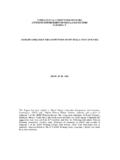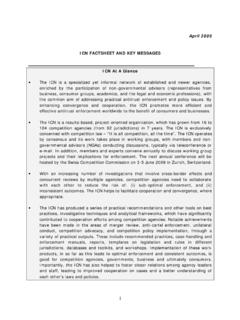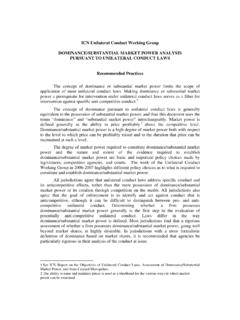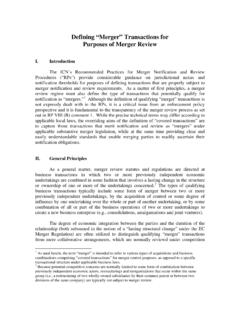Transcription of ADVOCACY AND COMPETITION POLICY
1 ADVOCACY AND COMPETITION POLICYR eport prepared by theAdvocacy Working GroupICN s ConferenceNaples, Italy, 2002 INTERNATIONAL COMPETITION NETWORKADVOCACY AND COMPETITION POLICYR eport prepared by theAdvocacy Working GroupICN s ConferenceNaples, Italy, 2002 INTERNATIONAL COMPETITION NETWORKDIRECTORYADVOCACY WORKING GROUPFERNANDO S NCHEZ UGARTEC hairmanMexicoALLAN FELSA ustraliaCHRIS WESTC anadaM NICA SALAMANCA MARALLAC hileGEORG ROEBLINGE uropean UnionJEROME GALLOTF ranceALBERTO HEIMLER ItalyHIROSHI UENOJ apanJOSEPH SEON HURK oreaJUSTYNA MICHALIKP olandTHEODOR VALENTIN PURCAREAR omaniaROGER FONESUSA, Department of Justice PAUL KARLSSONUSA, Federal Trade CommissionTAD ABBOT LIPSKYA merican Bar AssociationPRADEEP S. MEHTACUTSMARK SCHECHTERI nternational Chamber of CommerceDAPHNE YONG-D`HERV International Chamber of CommerceDAVID E.
2 WHEELERICC/ BIACRUGHVIR SHYAM KHEMANILECGPAUL CRAMPTONOECDLENNART GORANSONOECDPHILIPPE BRUSICKUNCTADEXECUTIVE SUMMARYINTRODUCTION21 COMPETITION ADVOCACY : A CONCEPTUAL COMPETITION ADVOCACY : COMPETITION and The Role of The Political Content of COMPETITION ADVOCACY First? Developing and Transition Economies versus Developed Institutional The International Dimension of Advocacy40 COMPETITION ADVOCACY AS SEEN BY ICN MEMBER COUNTRIES: THE The COMPETITION Operational Autonomy of the COMPETITION ADVOCACY in the Regulatory and Legal Interaction between Enforcement and COMPETITION ADVOCACY and Public Resources Devoted to COMPETITION Evaluating and Improving International Dimension of Advocacy90 CONCLUSIONS93 ANNEX 197 ANNEX 2111 REFERENCES1152314 TABLE OF CONTENTSiEXECUTIVE SUMMARY1.
3 INTRODUCTIONThe Steering Group of the International COMPETITION Network (ICN) decided toundertake a study on COMPETITION ADVOCACY with the purpose of analyzing its rel-evance in fostering competitive markets and promoting social welfare. To thisend it established the ADVOCACY Working Group with the mandate to undertakeprojects with a view to recommend best practices to ICN members and to pro-vide them with information to support their ADVOCACY first project undertaken by the ADVOCACY Working Group was to hold aquestionnaire among ICN members about their ADVOCACY activities. The ques-tionnaire was designed and implemented by a special team of the MexicanFederal COMPETITION Commission, headed by Fernando S nchez Ugarte, vice-chairman of the Steering report presents a summary of the answers to the questionnaire.
4 It compris-es four sections: first an introduction; a second section setting out a conceptualframework for COMPETITION ADVOCACY ; the third section forming the main body ofthe report presenting the results of the questionnaire and a final section contain-ing conclusions. 2. COMPETITION ADVOCACY : A CONCEPTUAL FRAMEWORKIn the present report the following definition of COMPETITION ADVOCACY was adopted: COMPETITION ADVOCACY refers to those activities conducted by the competi-tion authority related to the promotion of a competitive environment foreconomic activities by means of non-enforcement mechanisms, mainlythrough its relationships with other governmental entities and by increasingpublic awareness of the benefits of first part of this definition refers to practically all activities of the competitionauthority that do not fall under the enforcement category.
5 The second partdefines two main branches of ADVOCACY : (i) activities directed at other publicauthorities in charge of regulation or rule making and (ii) activities directed at allconstituencies of the society with the aim of raising their awareness of the ben-EXECUTIVE SUMMARYiiiEXECUTIVE SUMMARY iiefits of COMPETITION and of the role COMPETITION POLICY can play in the promotionand protection of may not only be hindered by privateanticompetitive conduct, suchas collusion among competitors, anticompetitive mergers, vertical arrangementsin restraint of COMPETITION and unilateral abuse of dominant positions, but also,in certain circunstances, by publicregulatory intervention and rulemaking. Suchregulatory intervention may be warranted in sectors featuring extensiveeconomies of scales or other market failures.
6 In particular, without intervention,some markets may fail to provide minimal levels of services considered of publicinterest. However, regulatory intervention may go beyond the strictly necessaryand may impede COMPETITION in those , economic regulation may give rise to the emergence of interestgroups(or interested parties) lobbying with the relevant authorities for the impo-sition of regulatory measures to their own benefit but eventually to the detrimentof the society as a whole, particularly the consumers. Some examples of the lat-ter are: unions of taxi-drivers lobbying with municipal authorities to limit thenumber of permits; trade associations lobbying for the imposition of compulsorysafety standards difficult to be met by new entrants or foreign suppliers.
7 In con-trast, regulators doing their job properly resist such pressures. There are examplesof public regulator acting against anticompetitive behavior of incumbent opera-tors or publicly owned companies after market opening: the telecommunicationsector provides good examples in the from the induced welfare losses, such conduct may lead to a substantialwaste of scarce resources in rent-seeking behavior by members of the interestgroups. At the same time there is a danger of regulatory captureof the involvedpublic countries with a COMPETITION law in force private anticompetitive conduct caneffectively be combated with the enforcementof such laws. In contrast, publicregulatory intervention, whether or not adopted in response to pressure fromspecial interest groups, is perfectly legal as a rule, and therefore harder to beinfluenced.
8 What COMPETITION authorities can do in such cases is advocating withthe relevant government agencies for the rejection of unnecessarily anticompet-itive regulatory measures, or at least for the adoption of measures as competitionfriendly as possible. In other words, it is no longer enforcement powers but con-vincing arguments that advocacycomprises all activities by COMPETITION agencies pro-moting COMPETITION , which do not fall in the enforcement category. On onehand, this implies convincing other public authorities to abstain from adoptingunnecessarily anticompetitive measures, and helping regulatory agencies toclearly delineate the boundaries of economic regulation, to determinewhich markets are characterized by natural monopolies or other market fail-ures, where regulation rather than COMPETITION should be the disciplinary force,and which markets are more susceptible to the competitive process.
9 On theother hand, COMPETITION ADVOCACY comprises all efforts by COMPETITION author-ities intended to make other government entities, the judicial system, econom-ic agents and the public at large more familiar with the benefits of competitionand with the role COMPETITION law and POLICY can play in promoting and pro-tecting welfare enhancing COMPETITION wherever possible. This implies a vari-ety of activities among which seminars for business representatives, lawyers,judges, academics, etc. on specific COMPETITION issues, press releases about cur-rent enforcement cases, the publication of annual reports and guidelines set-ting out the criteria followed to resolve COMPETITION cases, are just a few exam-ples.
10 It is generally recognized that such activities enhance the transparency ofcompetition POLICY along with the credibility and the convincing power of theenforcement those activities contribute to establish, what is often called, a COMPETITION cul-ture, which is perhaps best characterized by the awareness of economic agentsand the public at large about COMPETITION rules. Thus, all efforts on behalf ofcompetition authorities to make these rules known and understood are positivecontributions to the COMPETITION culture. It has often been argued that in transition and developing countries competitionauthorities should give priority to ADVOCACY over enforcement activities. One ofthe arguments is that in those countries many state assets are privatized whichgives rise to an intensive rule making process in which COMPETITION ADVOCACY hasan important role to play.









![[MERGER NOTIFICATION PROCEDURE TEMPLATE]](/cache/preview/4/4/e/2/5/9/d/c/thumb-44e259dc3896a9580aeac27f113f9044.jpg)



